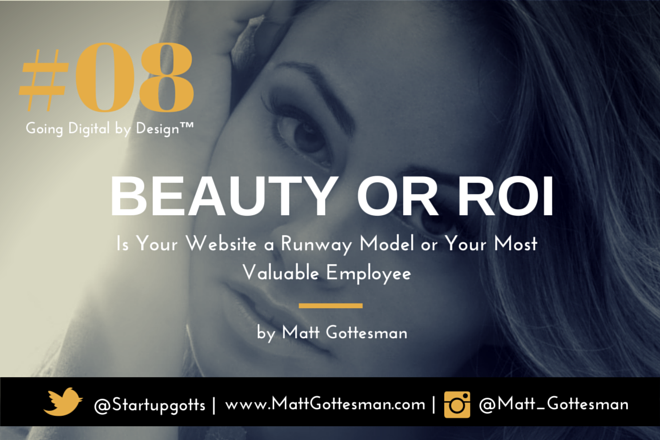Is Your Website Your Runway Model or Your Most-Valuable Employee?
What’s the difference? One is nice to look at while the other one makes you money. The former represents your company, while the latter builds it. The model endorses the product, but the employee manages the company and systems that produce the product, distribute it, market it and sell it.
Why does this matter? Well, we’re doing business in a time where websites can no longer sit there, look nice and do nothing for our bottom line. They must be earning us revenue, increasing our leads and driving us business – even while we sleep.
See, many companies, brands or even individuals have built amazing looking websites, but those sites are not necessarily producing them income. They are typically “me-centric” focused. A website should be your employee, not the other way around.
In essence, sites need to be “you-centric” focusing its attention on the customer and having all the right backend systems to service them, while making you money.
And yes, we’re all guilty of this at some point . . . and I’m no different (PS – I’m currently working on my 2.0 as I type this).
You may be asking,
We’re a service-based company. Aren’t we supposed to list off all of our services and then have the client contact us?
Yes, but not in a “me-centric” way. You must find a way to be “you-centric” so they get the best possible value for their visit.
In other words, instead of showcasing all of your service offerings, what can you give them today that immediately helps them before they continue engaging with you further?
You can do this through a blog signup, free PDFs that help them with their business, access to a variety of resources and tools, etc.
See, relationships are at the heart of doing business. You must show respect and provide value before converting visitors to leads.
So, here’s a checklist to determine whether or not you have a Runway Model or a Most Valuable Employee for your site
The Runway Model:
You know your website is a runway model if it’s . . .
1.Pretty to look at but unapproachable – It looks nice. Visuals are great, but does it tell a story and guide the visitor through to the next steps?
2. “Me-Centric” – It’s focused inward shouting, “Here I am. Here’s what I have.” It should be “you-focused” towards the client.
3. Using big fancy words to impress – It should be simple.
4. Too polished – Your site should look good, but from well thought out design based on the what customers are looking for. A great user experience must evolve with the customer and ongoing feedback. It’s never perfect.
5. Providing too many bells and whistles – LESS IS MORE!!! Your customer only cares if you provide them with their basic needs and then grow with them from there.
The Most Valuable Employee:
You know your website is a valuable employee if it’s . . .
1. “You-Centric” – Speak directly to your intended audiences, their problems and guide them through to meaningful solutions or interactions.
2. Offering value at every touch point – Make them want to click or take a piece of you with them.
3. Automated and working around the clock – Visitors / customers should be able to interact with you at all times, but not at the cost of your livelihood. Automation allows you or your company to handle multiple tasks and customers, but in a way that frees up more time for you or other activities that build your business.
In some cases, it’s about having more time to do whatever you want. If you develop this component correctly, they’ll feel like you are able to take care of them personally and you’ll feel less overwhelmed.
4. Simple to follow – Here’s how simple it needs to be. A visitor comes to your site, they immediately see something that resonates with them, you provide a valuable offering or set of offerings, they easily understand what you are giving them and they click through to convert (get on an email list, gain access to free downloads / trials, purchase a product, get in touch with you or a member of your company, etc.)
Here’s the kicker, A LOT of companies may have these components on their site, but they often have them fragmented and displayed in the wrong areas. HUGE miss!! You have to think like the customer and build website real estate according to what they want to experience.
5. Easy to understand – You have to speak to your audience like your talking to a 7 grader. Do not try to WOW them with verbiage based on your industry expertise. Wow them because you explained it in layman terms (a person who is not a member of a particular profession or industry). Do this and they will love you.
Crawl Before You Walk
Please keep in mind, designing a “you-centric” site requires strategy before implementation. What do I mean by that?
You need to think through who you’re doing this for, what they care about, how to speak directly to their problems, what various levels of solutions are you going to give them, how will you continuously engage with them and then write all the content. Let’s not forget, you then have to build the infrastructure on the backend of your website to automate your business.
You still think it’s just a website?
I can tell you, it’s a lot of work, but it pays.
A Few Resources To Help You Think Through the User Experience:
I always like ending an article by providing a few resources that may be of a help to the reader. Here are 3 resources that may be useful as you begin to think through building web assets that matter to your target audiences:
- UX Magazine – This site is great for articles on creating better user experiences that matter to your customer (i.e. Design, eCommerce, Marketing, Branding, etc.)
- UX Booth – Similar to UX Magazine, UX Booth offers great articles on Visual Design, Interaction Design and Information Architecture, but I like that it also offers CONTENT STRATEGY. This is HUGE!!! UX Booth also offers great resources and tools to consider.
- Mindmeister – A great app for brainstorming customer journeys. Once you figure out the preliminary stuff your customer or client wants, you can use this tool to really think through how you want to guide them throughout your site.
If you’re really not sure where to begin when it comes to the first steps (i.e. digital strategy branding/rebranding, resources, whatever), feel free to reach out to me at [email protected] and we’ll talk.
Have you or your company ever faced dealing with a website that looks good but doesn’t convert? Please feel free to share below. I’d love to hear from you.
If you liked this post and you think others could benefit from reading, please feel free to share.
##
Photo Credit: Image in Header Graphic courtesy of Canva.com








